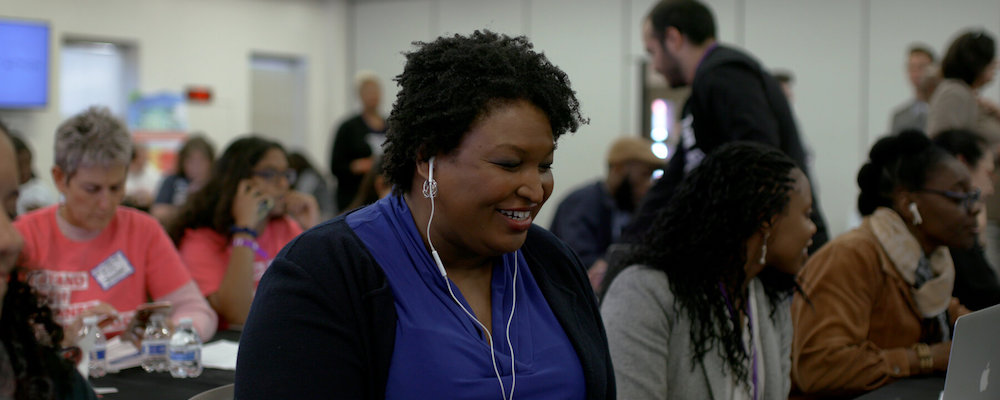‘All In: The Fight For Democracy’ Takes Aim at Voter Suppression Without Losing Sight of Solutions
Tony Sokol
Stacey Abrams grew up with three parental directives: she had to go to school, she had to go to church, and she had to help a stranger in a significant way. Her parents dropped her off at soup kitchens and other functions where she could do the most good. The Democratic Party’s nominee in the 2018 Georgia gubernatorial race was raised for public service. “All In: The Fight for Democracy,” Amazon Studios’ documentary investigation on voter suppression, shows the public is being done a disservice. For all Abrams’ education and close family values, she was raised wrong. The system doesn’t care about the public. It was designed for political favoritism.
When President Trump threatens a 12-year rusted iron fist rule because the election system is rigged, he has a point. It is. It was designed that way. The Founding Fathers, in their deistic, enlightened plan to overthrow monarchy, kept the keys to power to a select few. Only white, male landowners were allowed to vote in the original law of the land, and that meant 94 percent of the population had no say in who did what in government. Women, slaves, and indigenous people weren’t even on the short list. Abrams, America’s first African-American female major-party gubernatorial nominee, was born to be suppressed. She lost to Brian Kemp because even if the rigged system failed, there were failsafe maneuvers to get around it.
It’s not like Abram’s constituents don’t take voting seriously. Directors Liz Garbus and Lisa Cortés interview voters trying to get to the polls, each of whom vow how it is almost a sacred duty to cast their vote. These people are believers. “All In: The Fight for Democracy” presents the Georgia election as a cautionary tale on the eve of the 2020 race. It is a call to arms, in a time when armed forces patrol civilian streets, to fight for the right to vote. Their weapon is education. Thank god they leave it to John Oliver to explain gerrymandering, though. While the opening of the documentary captures the suspense of the effectively illicit tactics used against Abrams, the bulk of it comes off as an infomercial.
This is fair, the documentary is scheduled to be released in time for National Voter Registration Day, and Abrams wants an informed electorate. She might have been the first Black woman governor in American history and she wants to be damned sure that title isn’t stolen from whoever comes next. The documentary shows voter suppression has been on the rise since 2013, when the Supreme Court gutted the Voting Rights Act. Oppressive tactics used in the Jim Crow era, like Billy clubs, police violence and lynchings, were replaced by strict voter ID laws, roll purging, poll closures, and the threat of a visible police presence at polls.
As archival footage rolls, we hear ominous stories of posses being formed to block voters. Abrams recounts a story she heard from a woman who was afraid to vote. She remembered the dogs and the fire-hoses and could not believe anything had changed. Abrams is positively giddy as she remembers the effect of the election of President Obama, but her face falls as she points out how the burst of new voters turned into a hit list for new suppression. Laws disproportionately affecting Black, Brown, poor, Indigenous, Latinx and young voters were backed up by continued harassment at the polls.
Experts, activists, witnesses and victims bridge the historic precedents with modern experiences. Abrams details stories of contemporary voters waiting in line for hours because of precinct consolidations. The film recounts the history of voter suppression which it traces back to the era that followed Reconstruction when Black officials were elected to state and federal offices. Black Codes criminalized normal behavior like arresting someone for loitering when they are looking for work, and lose their right to vote.
The archival footage carries a lot of dramatic weight. It captures Congressman John Lewis and the Rev. C.T. Vivian on their way to becoming civil rights icons. The documentary emotionally details Amelia Boynton’s mission to organize marches to Montgomery, Alabama, for voting rights. We hear the little-known victory of Mississippi’s Henrietta Wright who was arrested, beaten and jailed for registering to vote 20 days after the 1965 Voting Rights Act. Wright brought the first federal voting rights damage suit in 1968. Wright lost the case but won a battle.
Liz Garbus, whose father represented Wright, won two Emmys and was nominated for an Oscar for her second film “The Farm: Angola, USA,” which exposed life at maximum security prisons. Cortés’ directorial debut, “The Remix: Hip Hop X Fashion,” found hope in the endless creativity of street design. They artfully combine downtrodden with uplifting. Abrams’ gubernatorial race is a small part of a larger story. The 19th Amendment turned 100 years old on Aug. 18, and suffers from memory loss. “All In: The Fight for Democracy” is a timely reminder and a wakeup call. Saying every vote counts is meaningless if you don’t count the votes.
“All In: The Fight for Democracy” releases Sept. 9 in select theaters, and begins streaming Sept. 18 on Amazon Prime Video.

